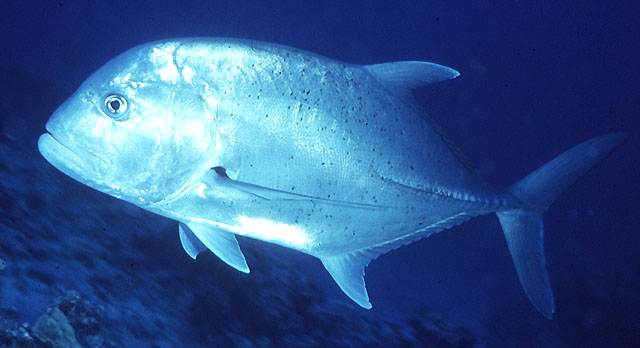| Carangidae (Jacks and pompanos), subfamily: Caranginae |
| 170 cm TL (male/unsexed); max.weight: 80 kg |
|
reef-associated; depth range 10 - 188 m |
| Indo-Pacific: Red Sea and east coast of Africa to the Hawaiian and Marquesan islands, north to southern Japan (Ref. 559) and the Ogasawara Islands, south to northern Australia. Hybrid with Caranx melampygus found in Hawaii (Ref. 58422). |
|
Dorsal spines (total): 9-9; Dorsal soft rays (total): 17-22; Anal spines: 3-3; Anal soft rays: 15-17. Description: Dusky golden or blackish to silvery grey dorsally, shading to silvery grey ventrally; often with scattered small dark spots, fins usually pigmented grey to black (Ref. 2334, Ref. 90102). Body oblong and compressed, dorsal profile strongly convex anteriorly, ventral profile slightly convex (Ref. 90102). Breast scaleless ventrally, typically with small to large patch of pelvic or prepelvic scales; LL scutes 26-38, strong (Ref. 2334, Ref. 90102). Pectoral fins falcate; anal fin with 2 detached spines (Ref. 2334). Adipose eyelid moderately developed, small anteriorly and extending forward to rear edge of pupil on posterior part of eye (Ref. 90102). |
| Pelagic over sand and rock (Ref. 58302). Adults occur singly and inhabit clear lagoon and seaward reefs (Ref. 9710). They feed on crustaceans (like crabs and spiny lobsters) and fishes at night (Ref. 4887). Large individuals may be ciguatoxic. The largest trevally, reaching 1.7 m in length and a weight of over 60 kg (Ref. 48635). Spawning occurs on shallow seaward reefs and offshore banks (Ref. 37816). Juveniles are found in estuaries. Sold mostly fresh and dried salted. |
|
(Ref. 96402)
|
| reports of ciguatera poisoning |
|
Source and more info: www.fishbase.org. For personal, classroom, and other internal use only. Not for publication.
Page created by Jen, 05.08.02,
php script by kbanasihan 06/09/2010 ,
last modified by
dsantos, 20/08/10

